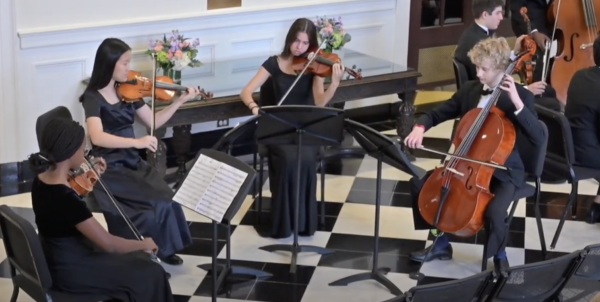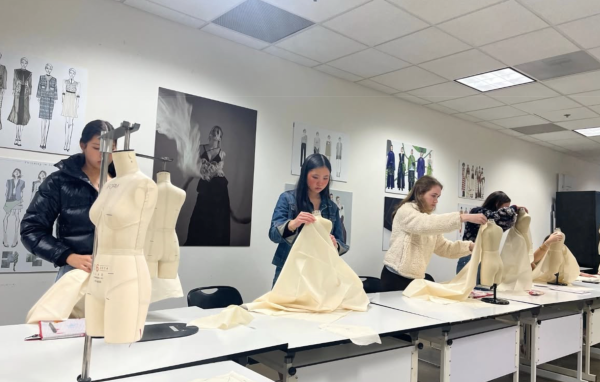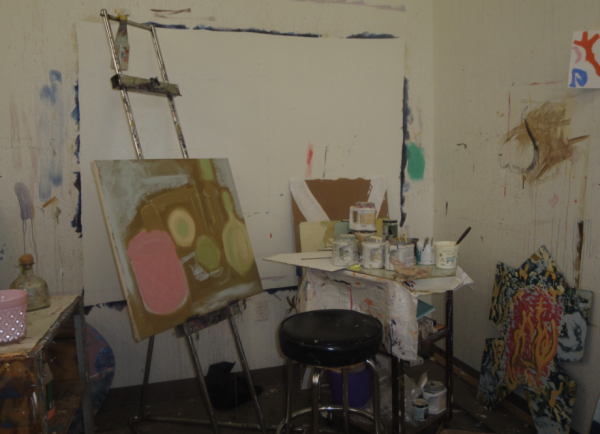First Broyles art exhibit of the year closes
On Dec. 9, artists began dismantling the first art show in Broyles this year. With works lining the foyer halls, the show featured an extensive range of pieces: every student in an art class had artwork in the show.
Upper School art teacher Jen Marie Wentzel’s ceramics classes contributed three different projects in total to the exhibit. The works Wentzel’s students had in the exhibit were about figuring out the fundamentals of ceramics. The first piece that the Ceramics I class displayed was their monster projects. The students focused on expression and made three monsters—one from a solid block of clay and two from pinch pots.
“They had to focus on the negative space between their monsters and then the story that they were telling,” said Wentzel.
The second project that the Ceramics I class completed was a tile project that was less sculptural and more based on different techniques used to texture the clay.
“Really learning surface technique and a process called sgraffito, which is when you carve into the clay, then paint on top of that,” Wentzel explained. “The tiles were very technique driven while the monsters were definitely sculptural and expressive.”
While the students in Wentzel’s Ceramics I class had the option to choose between two projects they had finished to put in the exhibit, Wentzel’s Ceramics II class only had the option of one project for the exhibit because all of the other projects they had worked on were not finished. The project that was in the exhibit was called the smash project. For the smash project, the students each worked with a large block of clay that they sculpted into a basic shape, then took multiple tools and smashed the clay. They then let it dry and hollowed out the clay.
“It’s all about capturing action in the clay body,” said Wentzel. “It’s really based on abstract expressionists and how they painted and then taking that into the clay body.”
While the ceramics classes focused more on 3D sculptures, the drawing and painting classes focused on 2D artworks.
The Drawing and Painting I classes, taught by Pamela Martinez, did two projects, the first being a watercolor project. For this piece, the students first practiced individual techniques, like using wet watercolor on wet paper, a technique called “drag the blob,” which involves putting a drop of color on paper and dragging it with a paintbrush. The students then traced a stencil and used two of the watercolor techniques they had learned to fill in their work.
The second piece the Drawing and Painting I class completed was a mixed-media project where the students took a picture of an object, put it into Photoshop, added a background, and played with the size and repetition of the object. The students printed out the Photoshop collages and then drew and painted directly on them.
“They had to incorporate techniques from two professional artists [Brian McCarty and Pelle Cass], one technique being repetition and the other being playing with scale and proportion, making things really big and really small,” said Martinez.
The pieces from the Drawing and Painting II class were five-foot by seven-foot paintings of either a villain, a character, or a superhero.
“We made these giant paintings that are hanging from the second floor because they are so large,” said Martinez.
In order to make the background for these paintings, the class went to the ropes course by the Westminster summer camp and dripped paint onto the canvases from 20 feet up in the air. Next, the students studied the style of comic art and started painting their characters.
“This year, all of my projects were new, so it was really fun to see all these new things come out that I had never seen before,” said Martinez.
Ben Steele teaches four Upper School classes in different art areas, including Photography, AP Drawing and Painting, and 3D Design. Almost every student in Steele’s AP Drawing and Painting class has their card series in the exhibit, which is a series of seven small works based on playing cards.
“What’s really cool about that project is that you really get a strong sense of voice from every student because they are thinking about what they want to do moving forward,” said Steele. “The card project is also one of the only projects that remains the same year after year.”
The students had to make one card per day, so it was a swift way to start the year; however, it helped the students discover what theme they wanted their art to surround for the rest of the year. In doing the project that way, each set of cards had a different theme.
“It’s really a fast rapid-fire way we start the year in which they’re brainstorming ideas for what they’re going to do the rest of the year,” said Steele.
Steele’s 3D Design class had a similar project put in the exhibit, which also included completing seven pieces in seven days; however, only one or two of the seven works from each student were displayed in the exhibit, whereas for the Drawing and Painting classes card project, all seven cards were in the show. The 3D Design class’s project focused on using unconventional materials and items and putting them together to make a sculpture. For example, one student put together light bulbs and paperclips.
“That project was all about labeling certain elements and principles of design and representing them through form,” said Steele.
Because this project was very temporary and fragile, only photographs of the pieces were in the exhibit as opposed to the physical pieces.
“I encourage everyone to check out future art shows,” said Steele. “The shows are a great way to look at what different art classes are doing and what art classes you might want to take in the future.”



